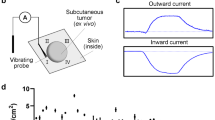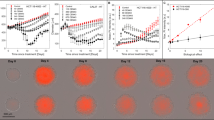Summary
A new method was tested for studies of penetration of substances into tumorlike tissue. The penetration of the ions K+, Cl−, and Ca2+ through several layers of tumor cells was demonstrated by using double barrelled, ion sensitive microelectrodes with extra thin tip diameters. Spheroids consisting of human glioma, U-118 MG, and human thyroid cancer, HTh-7, cells were used as models of tumor tissue. A microelectrode was inserted into the center of a spheroid. Thereafter, the concentration of the test substance was increased in the surrounding medium. The change in concentration inside the spheroid was recorded and the penetration pattern evaluated. All three types of tested ions penetrated easily through the spheroids. The K+ ions penetrated most efficiently, and the Ca2+ ions showed the slowest penetration. The Ca2+ ions penetrated somewhat more slowly in the U-118 MG spheroids (which had rather small extracellular spaces) than in the HTh-7 spheroids (which had larger extracellular spaces). Ion sensitive electrodes, which are easily available, were used in this study only to demonstrate the principle. We hope that the method described can be used for penetration studies of various substances. For example, all substances that can be detected by enzyme microelectrodes could be studied. The main advantage of the method is that the complete penetration pattern can be studied as a function of time in individual spheroids. Previously described methods require histological procedures for each analyzed penetration time.
Similar content being viewed by others
References
West, G. W.; Weichselbaum, R.; Little, J. B. Limited penetration of methotrexate into human osteosarcoma spheroids as a proposed model for solid tumor resistance to adjuvant chemotherapy. Cancer Res. 40: 3665–3668; 1980.
Nederman, T.; Carlsson, J.; Malmqvist, M. Penetration of substances into tumor tissue—A methodological study on cellular spheroids. In Vitro 17: 290–298; 1981.
Tuckwell, H. C.; Hermansen, C. L. Ion and transmitter movements during spreading cortical depression. Int. J. Neurosci. 12: 109–135; 1981.
Nicholson, C. Modulation of extracellular calcium and its functional implications. Fed. Proc. 39: 1519–1523; 1980.
Sutherland, R. M.; Eddy, H. A.; Bareham, B.; Reich, K.; Vanantwerp, D. Resistance to adriamycin in multicellular spheroids. Int. J. Radiat. Oncol. Biol. Phys. 5: 1225–1230; 1979.
Sutherland, R. M.; McCredie, J. A.; Inch, W. R. Growth of multicell spheroids in tissue culture as a model of nodular carcinomas. J. Natl. Cancer Inst. 46: 113–120; 1971.
Yuhas, J. M.; Li, A. P.; Martinez, A. O.; Ladman, A. J. A simplified method for production and growth of multicellular tumor spheroids. Cancer Res. 37: 3639–3643; 1977.
Haji-Karim, M.; Carlsson, J. Proliferation and viability in cellular spheroids of human origin. Cancer Res. 38: 1457–1464; 1978.
Carlsson, J. A proliferation gradient in three-dimensional colonies of cultured human glioma cells. Int. J. Cancer 20: 129–136; 1977.
Tannok, I. F. The relation between cell proliferation and the vascular system in a transplanted mouse mammary tumour. Brit. J. Cancer 22: 258–273; 1968.
Thomlinson, R. H.; Gray, L. H. The histological structure of some human lung cancers and the possible implications for radiotherapy. Brit. J. Cancer 9: 539–549; 1955.
Westermark, B.; Pontén, J.; Hugosson, R. Determinants for the establishment of permanent tissue culture lines from human gliomas. Acta Pathol. Microbiol. Scand. Section A 81: 791–805; 1973.
Carlsson, J.; Nilsson, K.; Westermark, B.; Pontén, J.; Sundström, C.; Larsson, E.; Bergh, J.; Pahlman, S.; Busch, C.; Collins, V. P. Formation and growth of multicellular spheroids of human origin. Int. J. Cancer 31: 523–533; 1983.
Acker, H.; Holterman, G.; Carlsson, J.; Nederman, T. Methodological aspects of microelectrode measurements in cellular spheroids. Matzka, J. ed. Oxygen transport to tissue—IV. New York: Plenum Publishing Corporation; 1983. In press.
Acker, H.; Dufau, E.; Sylvester, D. Ionsensitive microelectrode with extra thin tip diameter for intracellular measurements. Pflüegers Arch. 373: R91; 1978.
Dufau, E.; Acker, H.; Sylvester, D. Double-barrel ion sensitive microelectrodes with extra thin tip diameters for intracellular measurements. Med. Prog. Technol. 7: 35–39; 1980.
Weibel, E. R.; Elias, H. Quantitative methods in morphology. Berlin-Heidelberg-New York: Springer Verlag; 1967: 91–93.
Carlsson, J.; Brunk, U. The fine structure of three-dimensional colonies of human glioma cells in agarose culture. Acta Pathol. Microbiol. Scand. Sec. A85: 183–192; 1977.
Sten-Knudsen, O. Passive transport processes. Giebisch, G.; Tosteson, D. C.; Ussing, H. H. eds. Membrane transport in biology, Vol. 1. Berlin-Heidelberg-New York: Springer Verlag; 1978: 5–113.
Wang, J. H. Tracer diffusion in liquids. IV. Self-diffusion of calcium ion and chloride ion in aqueous calcium chloride solutions. J. Am. Chem. Soc. 75: 1769–1770; 1953.
Bawin, S. M.; Adey, W. R.; Sabbot, I. M. Ionic factors in release of45Ca2+ from chicken cerebral tissue by electromagnetic fields. Proc. Natl. Acad. Sci. USA 75: 6314–6318; 1978.
Racker, E. Mechanisms of ion transport and ATP formation. Giebisch, G.; Tosteson, D. C.; Ussing, H. H. eds. Membrane transport in biology, Vol. 1. Berlin-Heidelberg-New York: Springer Verlag; 1978: 259–290.
Borle, A. B. Control, modulation, and regulation of cell calcium. Rev. Physiol. Biochem. Pharmacol. 90: 14–153; 1981.
Hagiwara, S. The Ca ion permeability of the cell membrane. Jpn. Circ. J. 44: 239–248; 1980.
Acker, H.; Carlsson, J. Measurements of potassium activities and membrane potentials in tumour cells. Lübbers, D. W.; Acker, H.; Buck, R. P.; Eisenmann, G.; Kessler, M.; Simon, W. eds. Progress in enzyme and ion-selective electrode. Berlin-Heidelberg-New York: Springer Verlag; 1981: 226–230.
Carlsson, J.; Stalnacke, C. G.; Acker, H.; Haji-Karim, M.; Nilsson, S.; Larsson, B. The influence of oxygen on viability and proliferation in cellular spheroids. Int. J. Radiat. Oncol. Biol. Phys. 5: 2011–2020; 1979.
Mueller-Klieser, W. F.; Sutherland, R. M. Oxygen tensions in multicell spheroids of two cell lines. Brit. J. Cancer 45: 256–264; 1982.
Author information
Authors and Affiliations
Additional information
The work has been supported financially by the Max-Planck-Gesellschaft, Munich, the Swedish Cancer Society, and the Swedish National Defence Research Institute.
Rights and permissions
About this article
Cite this article
Nederman, T., Acker, H. & Carlsson, J. Penetration of substances into tumor tissue: A methodological study with microelectrodes and cellular spheroids. In Vitro 19, 479–488 (1983). https://doi.org/10.1007/BF02619595
Received:
Accepted:
Issue Date:
DOI: https://doi.org/10.1007/BF02619595




